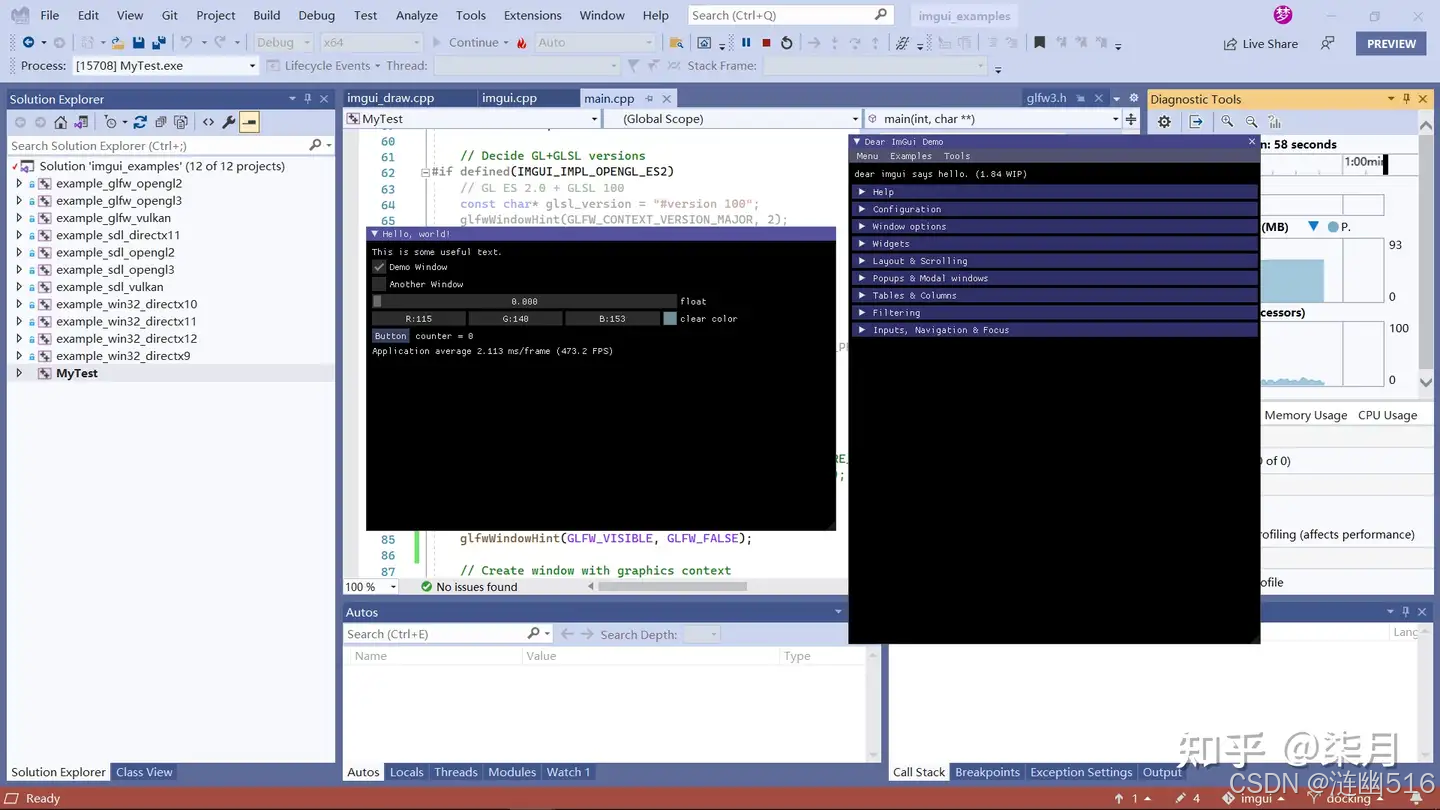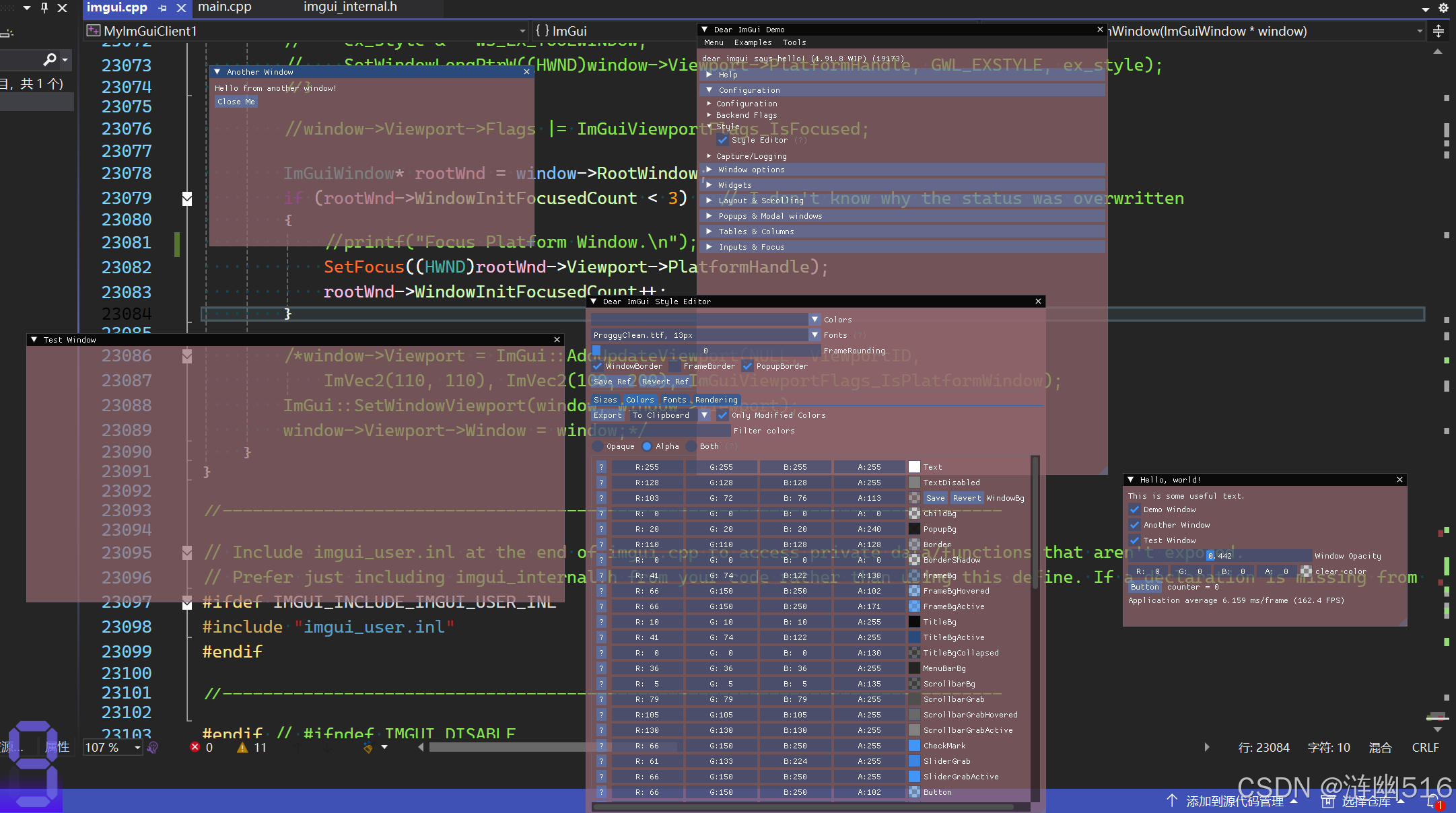ImGui 的主窗口是平台窗口,默认是可见的,这会影响视觉效果。那么怎么隐藏 ImGui 的主窗口呢?
这很简单,但是需要针对后端做一些修改。
本文仅介绍在 glfw+opengl3 和 win32+dx11 两种实现上如何修改。
在 win32+dx11 实现上,隐藏主窗口首先需要找到 issues 中关于窗口背景透明度的临时解决方案,实施这些方案。我们最好在窗口透明的基础上隐藏平台窗口。
你可以参考:
为 DX12 后端添加 DirectComposition (用于透明度) 作者 Soreepeong ·拉取请求 #7462 ·奥科努特/IMGUI
然后,我们现在可以为 Viewports 开启混合透明(每像素透明度)。然后,设置 clear_color 的Alpha 通道数值为0,也就是完全透明。
这样,主视口(ID: 0x11111111)上面将不会渲染任何颜色。
1)隐藏主视口的平台窗口
随后,我们将 Win32 窗口的设置进行调整,主要是消除任务栏图标、窗口边框、标题栏、以及使得窗口不遮挡任何屏幕内容。
你可能会觉得使用 WS_EX_TRANSPATENT 有用,其实它只在使用分层透明度时候比较合适,而分层透明的效率没有混合透明高,所以我没采用。
然后,我们在平台窗口创建时候,指定 WS_POPUP WS_EX_TOOLWINDOW 以便于不在任务栏显示平台窗口的图标。
设置窗口位置大小为 pos = (0,0) , size = (1,1),矩形大小不能为 0,为 0 会导致 Imgui 的一些异常状态,最终导致界面无法响应。
其实到这里已经实现了隐藏主视口的平台窗口了。但是有一些细节仍需要处理。
接下来在 ImGuiWindow 结构中添加一个字段 bool WindowInitFocused。在 imgui_internal.h 中添加声明:
IMGUI_API void FocusRootPlatformWindow(ImGuiWindow* window);然后在 imgui.cpp 的最后,添加实现:
void FocusRootPlatformWindow(ImGuiWindow* window)
{
ImGuiContext& g = *GImGui;
ImGuiWindow* rootWnd = window->RootWindow;
if (!rootWnd->WindowInitFocused) // I don't know why the status was overwritten
{
// Before updating the platform window data for the first frame,
// PlatformUserData may be nullptr, and no actual processing should be performed at this time.
if (rootWnd->Viewport->PlatformUserData == nullptr) return;
g.PlatformIO.Platform_SetWindowFocus(rootWnd->Viewport);
rootWnd->WindowInitFocused = true;
}
}这样在 每次 ImGui::Begin() 后都可以调用一次:
ImGui::FocusRootPlatformWindow(ImGui::GetCurrentWindow());来触发平台窗口的焦点获取,ImGui 在获取焦点时候才会去检查更新 Viewport 和 Window 的关系。任务栏不显示图标的原因就在这里面,但我还没有具体确定具体原因。强制平台窗口获取焦点暂时解决了任务栏不显示图标的问题。
当前的 WindowSelectViewport(window) 调用(未来可能被重写)会将 ImGui 窗口移动到新的 Viewport。不过存在一个 bug,即使用 Imgui 窗口的 id, pos 和 size 作为 viewport 的相应参数,这会导致什么呢?平台窗口的边框和标题栏占据空间,使得 imgui 窗口不对齐。
WindowSelectViewport(window);
SetCurrentViewport(window, window->Viewport);
window->FontDpiScale = (g.IO.ConfigFlags & ImGuiConfigFlags_DpiEnableScaleFonts) ? window->Viewport->DpiScale : 1.0f;
SetCurrentWindow(window);目前,一种方法是修复 WindowSelectViewport 中的 AddUpdateViewport 的最后一个参数,由默认标识符改为 NoDecoration 即无平台窗口装饰。

其实也不能说这里有错,其实并没有错,只是我们在使用的时候需要注意:
需要在 WindowSelectViewport 调用之后为 Viewport 添加 ImGuiViewportFlags_NoDecoration 这个标识符,来正确去除平台窗口的装饰,而不是自己去调用 SetWindowLongPtr 这样的 api:
WindowSelectViewport(window);
window->Viewport->Flags |= ImGuiViewportFlags_NoDecoration;另一种隐藏平台窗口的实现是使用分层透明,这里我也介绍一下,就是在 Win32 窗口创建时使用纯色画刷,然后使用 SetLayeredWindowAttribute 将背景色去除,将平台窗口设置为无边框全屏窗口(注意不是独占显示器的窗口),然后给窗口添加 WS_EX_TRANSPARENT 样式,这将允许在窗口完全透明的位置穿透鼠标、键盘消息。看上去就像没有窗口了一般。
diff --git a/examples/example_win32_directx11/main.cpp b/examples/example_win32_directx11/main.cpp
index fe462e74..b73f127a 100644
--- a/examples/example_win32_directx11/main.cpp
+++ b/examples/example_win32_directx11/main.cpp
@@ -28,7 +28,7 @@ int main(int, char**)
// Create application window
WNDCLASSEX wc = { sizeof(WNDCLASSEX), CS_CLASSDC, WndProc, 0L, 0L, GetModuleHandle(NULL), NULL, NULL, NULL, NULL, _T("ImGui Example"), NULL };
::RegisterClassEx(&wc);
- HWND hwnd = ::CreateWindow(wc.lpszClassName, _T("Dear ImGui DirectX11 Example"), WS_OVERLAPPEDWINDOW, 100, 100, 1280, 800, NULL, NULL, wc.hInstance, NULL);
+ HWND hwnd = ::CreateWindowEx(WS_EX_LAYERED, wc.lpszClassName, _T("Dear ImGui DirectX11 Example"), WS_POPUP, 0, 0, GetSystemMetrics(SM_CXSCREEN), GetSystemMetrics(SM_CYSCREEN), NULL, NULL, wc.hInstance, NULL);
// Initialize Direct3D
if (!CreateDeviceD3D(hwnd))
@@ -75,7 +75,7 @@ int main(int, char**)
// Our state
bool show_demo_window = true;
bool show_another_window = false;
- ImVec4 clear_color = ImVec4(0.45f, 0.55f, 0.60f, 1.00f);
+ float clear_color[] = { 0, 0, 0, 0 };
// Main loop
MSG msg;
@@ -115,7 +115,7 @@ int main(int, char**)
ImGui::Checkbox("Another Window", &show_another_window);
ImGui::SliderFloat("float", &f, 0.0f, 1.0f); // Edit 1 float using a slider from 0.0f to 1.0f
- ImGui::ColorEdit3("clear color", (float*)&clear_color); // Edit 3 floats representing a color
+ ImGui::ColorEdit3("clear color", clear_color); // Edit 3 floats representing a color
if (ImGui::Button("Button")) // Buttons return true when clicked (most widgets return true when edited/activated)
counter++;
@@ -139,11 +139,28 @@ int main(int, char**)
// Rendering
ImGui::Render();
g_pd3dDeviceContext->OMSetRenderTargets(1, &g_mainRenderTargetView, NULL);
- g_pd3dDeviceContext->ClearRenderTargetView(g_mainRenderTargetView, (float*)&clear_color);
+ g_pd3dDeviceContext->ClearRenderTargetView(g_mainRenderTargetView, clear_color);
ImGui_ImplDX11_RenderDrawData(ImGui::GetDrawData());
+
+ BLENDFUNCTION blend = { AC_SRC_OVER, 0, 0, AC_SRC_ALPHA };
+ POINT pt = { 0, 0 };
+ SIZE sz = { 0, 0 };
+ IDXGISurface1 *pSurface = NULL;
+ HDC hDC = NULL;
g_pSwapChain->Present(1, 0); // Present with vsync
//g_pSwapChain->Present(0, 0); // Present without vsync
+ g_pSwapChain->GetBuffer(0, IID_PPV_ARGS(&pSurface));
+
+ DXGI_SURFACE_DESC desc;
+ pSurface->GetDesc(&desc);
+ sz.cx = desc.Width;
+ sz.cy = desc.Height;
+
+ pSurface->GetDC(FALSE, &hDC);
+ ::UpdateLayeredWindow(hwnd, nullptr, nullptr, &sz, hDC, &pt, 0, &blend, ULW_COLORKEY);
+ pSurface->ReleaseDC(nullptr);
+ pSurface->Release();
}
// Cleanup
@@ -162,16 +179,18 @@ int main(int, char**)
bool CreateDeviceD3D(HWND hWnd)
{
+ RECT rcWnd;
+ GetWindowRect(hWnd, &rcWnd);
// Setup swap chain
DXGI_SWAP_CHAIN_DESC sd;
ZeroMemory(&sd, sizeof(sd));
sd.BufferCount = 2;
- sd.BufferDesc.Width = 0;
- sd.BufferDesc.Height = 0;
- sd.BufferDesc.Format = DXGI_FORMAT_R8G8B8A8_UNORM;
+ sd.BufferDesc.Width = rcWnd.right - rcWnd.left;
+ sd.BufferDesc.Height = rcWnd.bottom - rcWnd.top;
+ sd.BufferDesc.Format = DXGI_FORMAT_B8G8R8A8_UNORM;
sd.BufferDesc.RefreshRate.Numerator = 60;
sd.BufferDesc.RefreshRate.Denominator = 1;
- sd.Flags = DXGI_SWAP_CHAIN_FLAG_ALLOW_MODE_SWITCH;
+ sd.Flags = DXGI_SWAP_CHAIN_FLAG_ALLOW_MODE_SWITCH | DXGI_SWAP_CHAIN_FLAG_GDI_COMPATIBLE;
sd.BufferUsage = DXGI_USAGE_RENDER_TARGET_OUTPUT;
sd.OutputWindow = hWnd;
sd.SampleDesc.Count = 1;glfw+opengl3 实现上:
使用 ImGui 的 docking 分支(需要 Multi Viewports 功能(官方描述:Multi-viewports is the feature allowing you to seamlessly extract Dear ImGui windows out of your main rendering context.)
然后使用 glfw 创建一个 offscreen context ,即在创建窗口前加入以下代码即可。
glfwWindowHint(GLFW_VISIBLE, GLFW_FALSE); // 设置 offscreen context 的标志位
// 需要在创建窗口前设置标志
// Create window with graphics context
GLFWwindow* window = glfwCreateWindow(200, 1, "Dear ImGui GLFW+OpenGL3 example", NULL, NULL);同时记得检查代码中的这一部分内容,检查有没有启动 docking 和 viewport 支持,假如这一段编译错误,说明还没有切换到 docking 分支。
// Setup Dear ImGui context
IMGUI_CHECKVERSION();
ImGui::CreateContext();
ImGuiIO& io = ImGui::GetIO();
(void)io; // 避免 unused 变量的警告
io.ConfigFlags |= ImGuiConfigFlags_NavEnableKeyboard; // Enable Keyboard Controls
//io.ConfigFlags |= ImGuiConfigFlags_NavEnableGamepad; // Enable Gamepad Controls
io.ConfigFlags |= ImGuiConfigFlags_DockingEnable; // !!! 启用 docking 功能的支持
io.ConfigFlags |= ImGuiConfigFlags_ViewportsEnable; // !!! 启用 viewport 功能的支持
io.ConfigViewportsNoAutoMerge = true; // 参考评论,建议加上这行
//io.ConfigViewportsNoTaskBarIcon = true;效果图:

此方法来源:https://www.zhihu.com/question/336183356/answer/1948292375。
最后,貌似还有一种折中的办法,就是把 ImGui Main Window 的大小绘制得和平台窗口一样大即可,并且去除平台窗口的边框装饰,将平台窗口改成背景透明使得拖动时候不会“穿帮”。
例如 dx11 的实现:
主要通过移除 imgui 窗口标题栏并使其填充整个 DirectX11 窗口,将两个窗口“融合”在一起。
要实现此操作,只需在 ImGui::Begin()中将 ImGuiWindowFlags_NoTitleBar 标志传递给 ImGui 窗口(根据需要,可能还需要 ImGuiWindowFlags_NoMove 和 ImGuiWindowFlags_NoResize)
在 ImGui::Begin()之前添加 ImGui::SetNextWindowPos()和 ImGui::SetNextWindowSize()指令,将 imgui 窗口放置在左上角并调整其大小以适应 DirectX11 窗口
最终,你应该有类似下面的东西:
ImGuiWindowFlags window_flags = 0;
window_flags |= ImGuiWindowFlags_NoTitleBar;
window_flags |= ImGuiWindowFlags_NoMove;
window_flags |= ImGuiWindowFlags_NoResize;
while(...) {
...
ImGui::SetNextWindowPos(ImVec2(0.0f, 0.0f)); // place the next window in the top left corner (0,0)
ImGui::SetNextWindowSize(ImGui::GetIO().DisplaySize); // make the next window fullscreen
ImGui::Begin("imgui window", NULL, window_flags) // create a window
...
}该方法来自:
https://stackoverflow.com/questions/74954814/remove-the-parent-default-window-in-imgui。
2)实现遍历窗口列表,新增窗口关闭检测(模仿 raylib):
添加下面代码,函数名也可以叫 GetWin32WindowShouldClose() / GetXXWindowShouldClose()。glfw 里面有一个叫 glfwSetWindowShouldClose 的实现来着。
namespace ImGui {
ImVector<ImGuiWindow*> GetImGuiWindowList()
{
ImGuiContext& g = *GImGui;
return g.Windows;
}
bool WindowCanShutdownNow(bool* p_open_main)
{
bool window_has_active = false;
if (!p_open_main || !(*p_open_main))
{
ImVector<ImGuiWindow*> windows = GetImGuiWindowList();
if (!windows.size())
{
return false;
}
for (const auto& window : windows)
{
// The "Debug##Default" window ImGui creates internally in NewFrame()
// It is hidden and has no owner Viewport.
if (window->Name && !stricmp(window->Name, "Debug##Default"))
continue;
//if (window->Active && window->ViewportOwned)
if (window->Active && !window->Hidden)
{
window_has_active = true;
break;
}
}
}
else
{
return false;
}
return !window_has_active;
}
}GetImGuiWindowList 在 imgui_internal.h 中声明,WindowCanShutdownNow 在 imgui.h 中声明。
窗口关闭检测怎么使用?
在消息循环中添加这样的代码:
while (!done)
{
// Poll and handle messages (inputs, window resize, etc.)
// See the WndProc() function below for our to dispatch events to the Win32 backend.
// 轮询和处理消息(输入、窗口大小调整等)
// 请参阅位于此页下方的 WndProc() 函数,了解如何将事件调度到 Win32 后端。
MSG msg;
while (::PeekMessage(&msg, nullptr, 0U, 0U, PM_REMOVE))
{
::TranslateMessage(&msg);
::DispatchMessage(&msg);
if (msg.message == WM_QUIT)
done = true;
}
if (done)
break;
// 下面是添加的窗口关闭检测,当所有 Imgui 窗口被关闭时,自动关闭平台窗口,并使得消息循环得以正常结束。
if (ImGui::WindowCanShutdownNow(&show_main_window))
PostMessageW(hwnd, WM_CLOSE, NULL, NULL);
......
}最终的效果:

本文出处链接:https://blog.csdn.net/qq_59075481/article/details/145773493。

























 1147
1147

 被折叠的 条评论
为什么被折叠?
被折叠的 条评论
为什么被折叠?










